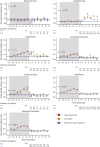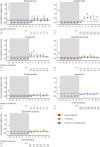Disease Reactivation After Cessation of Disease-Modifying Therapy in Patients With Relapsing-Remitting Multiple Sclerosis
- PMID: 35977837
- PMCID: PMC9620810
- DOI: 10.1212/WNL.0000000000201029
Disease Reactivation After Cessation of Disease-Modifying Therapy in Patients With Relapsing-Remitting Multiple Sclerosis
Abstract
Background and objectives: To evaluate the rate of return of disease activity after cessation of multiple sclerosis (MS) disease-modifying therapy.
Methods: This was a retrospective cohort study from 2 large observational MS registries: MSBase and OFSEP. Patients with relapsing-remitting MS who had ceased a disease-modifying therapy and were followed up for the subsequent 12 months were included in the analysis. The primary study outcome was annualized relapse rate in the 12 months after disease-modifying therapy discontinuation stratified by patients who did, and did not, commence a subsequent therapy. The secondary endpoint was the predictors of first relapse and disability accumulation after treatment discontinuation.
Results: A total of 14,213 patients, with 18,029 eligible treatment discontinuation epochs, were identified for 7 therapies. Annualized rates of relapse (ARRs) started to increase 2 months after natalizumab cessation (month 2-4 ARR 0.47, 95% CI 0.43-0.51). Commencement of a subsequent therapy within 2-4 months reduced the magnitude of disease reactivation (mean ARR difference: 0.15, 0.08-0.22). After discontinuation of fingolimod, rates of relapse increased overall (month 1-2 ARR: 0.80, 0.70-0.89) and stabilized faster in patients who started a new therapy within 1-2 months (mean ARR difference: 0.14, -0.01 to 0.29). The magnitude of disease reactivation for other therapies was low but reduced further by commencement of another treatment 1-10 months after treatment discontinuation. Predictors of relapse were a higher relapse rate in the year before cessation, female sex, younger age, and higher EDSS score. Commencement of a subsequent therapy reduced both the risk of relapse (HR 0.76, 95% CI 0.72-0.81) and disability accumulation (0.73, 0.65-0.80).
Discussion: The rate of disease reactivation after treatment cessation differs among MS treatments, with the peaks of relapse activity ranging from 1 to 10 months in untreated cohorts that discontinued different therapies. These results suggest that untreated intervals should be minimized after stopping antitrafficking therapies (natalizumab and fingolimod).
Classification of evidence: This study provides Class III that disease reactivation occurs within months of discontinuation of MS disease-modifying therapies. The risk of disease activity is reduced by commencement of a subsequent therapy.
© 2022 American Academy of Neurology.
Figures



Similar articles
-
Comparison Between Dimethyl Fumarate, Fingolimod, and Ocrelizumab After Natalizumab Cessation.JAMA Neurol. 2023 Jul 1;80(7):739-748. doi: 10.1001/jamaneurol.2023.1542. JAMA Neurol. 2023. PMID: 37273217 Free PMC article.
-
Discontinuation of disease-modifying treatments in multiple sclerosis to plan a pregnancy: A retrospective registry study.Mult Scler Relat Disord. 2020 Nov;46:102518. doi: 10.1016/j.msard.2020.102518. Epub 2020 Sep 16. Mult Scler Relat Disord. 2020. PMID: 32977075
-
Comparative effectiveness and cost-effectiveness of natalizumab and fingolimod in rapidly evolving severe relapsing-remitting multiple sclerosis in the United Kingdom.J Med Econ. 2024 Jan-Dec;27(1):109-125. doi: 10.1080/13696998.2023.2293379. Epub 2023 Dec 26. J Med Econ. 2024. PMID: 38085684
-
Annualized relapse rate of first-line treatments for multiple sclerosis: a meta-analysis, including indirect comparisons versus fingolimod.Curr Med Res Opin. 2012 May;28(5):767-80. doi: 10.1185/03007995.2012.681637. Epub 2012 Apr 24. Curr Med Res Opin. 2012. PMID: 22462530
-
Estimating the comparative efficacy of cladribine tablets versus alternative disease modifying treatments in active relapsing-remitting multiple sclerosis: adjusting for patient characteristics using meta-regression and matching-adjusted indirect treatment comparison approaches.Curr Med Res Opin. 2019 Aug;35(8):1371-1378. doi: 10.1080/03007995.2019.1585779. Epub 2019 Mar 29. Curr Med Res Opin. 2019. PMID: 30786783
Cited by
-
Chemokine-mediated cell migration into the central nervous system in progressive multifocal leukoencephalopathy.Cell Rep Med. 2024 Jul 16;5(7):101622. doi: 10.1016/j.xcrm.2024.101622. Epub 2024 Jun 24. Cell Rep Med. 2024. PMID: 38917802 Free PMC article.
-
De-escalating and discontinuing disease-modifying therapies in multiple sclerosis.Brain. 2025 May 13;148(5):1459-1478. doi: 10.1093/brain/awae409. Brain. 2025. PMID: 39707906 Free PMC article. Review.
-
Patient-centered pregnancy planning in multiple sclerosis: evidence for a new era.Arq Neuropsiquiatr. 2024 Oct;82(10):1-11. doi: 10.1055/s-0044-1791202. Epub 2024 Oct 2. Arq Neuropsiquiatr. 2024. PMID: 39357853 Free PMC article. Review.
-
Escalation Versus Induction/High-Efficacy Treatment Strategies for Relapsing Multiple Sclerosis: Which is Best for Patients?Drugs. 2023 Oct;83(15):1351-1363. doi: 10.1007/s40265-023-01942-0. Epub 2023 Sep 19. Drugs. 2023. PMID: 37725259 Free PMC article.
-
Comparative Effectiveness of Autologous Hematopoietic Stem Cell Transplant vs Fingolimod, Natalizumab, and Ocrelizumab in Highly Active Relapsing-Remitting Multiple Sclerosis.JAMA Neurol. 2023 Jul 1;80(7):702-713. doi: 10.1001/jamaneurol.2023.1184. JAMA Neurol. 2023. PMID: 37437240 Free PMC article.
References
-
- Kalincik T, Kubala Havrdova E, Horakova D, et al. . Comparison of fingolimod, dimethyl fumarate and teriflunomide for multiple sclerosis. J Neurol Neurosurg Psychiatry. 2019;90(4):458-468. - PubMed
-
- Warrender-Sparkes M, Spelman T, Izquierdo G, et al. , MSBase Study Group. The effect of oral immunomodulatory therapy on treatment uptake and persistence in multiple sclerosis. Mult Scler. 2016;22(4):520-532. - PubMed
-
- Hartung HP, Gonsette R, Konig N, et al. , Mitoxantrone in Multiple Sclerosis Study Group MIMS. Mitoxantrone in progressive multiple sclerosis: a placebo-controlled, double-blind, randomised, multicentre trial. Lancet. 2002;360(9350):2018-2025. - PubMed
-
- Sorensen PS, Bertolotto A, Edan G, et al. . Risk stratification for progressive multifocal leukoencephalopathy in patients treated with natalizumab. Mult Scler. 2012;18(2):143-152. - PubMed
-
- Berkovich R. Clinical and MRI outcomes after stopping or switching disease-modifying therapy in stable MS patients: a case series report. Mult Scler Relat Disord. 2017;17:123-127. - PubMed
Publication types
MeSH terms
Substances
LinkOut - more resources
Full Text Sources
Other Literature Sources
Medical
Research Materials
